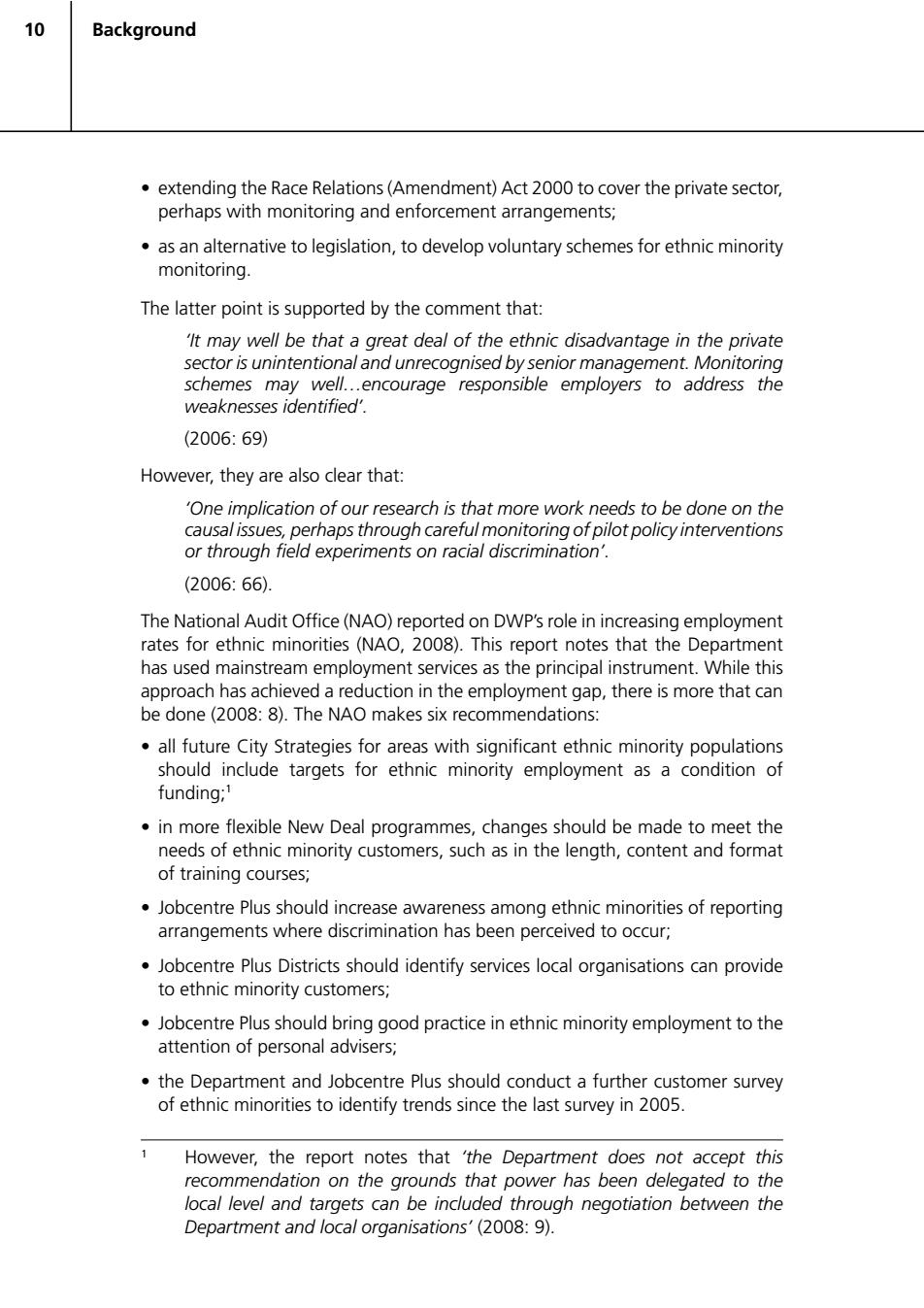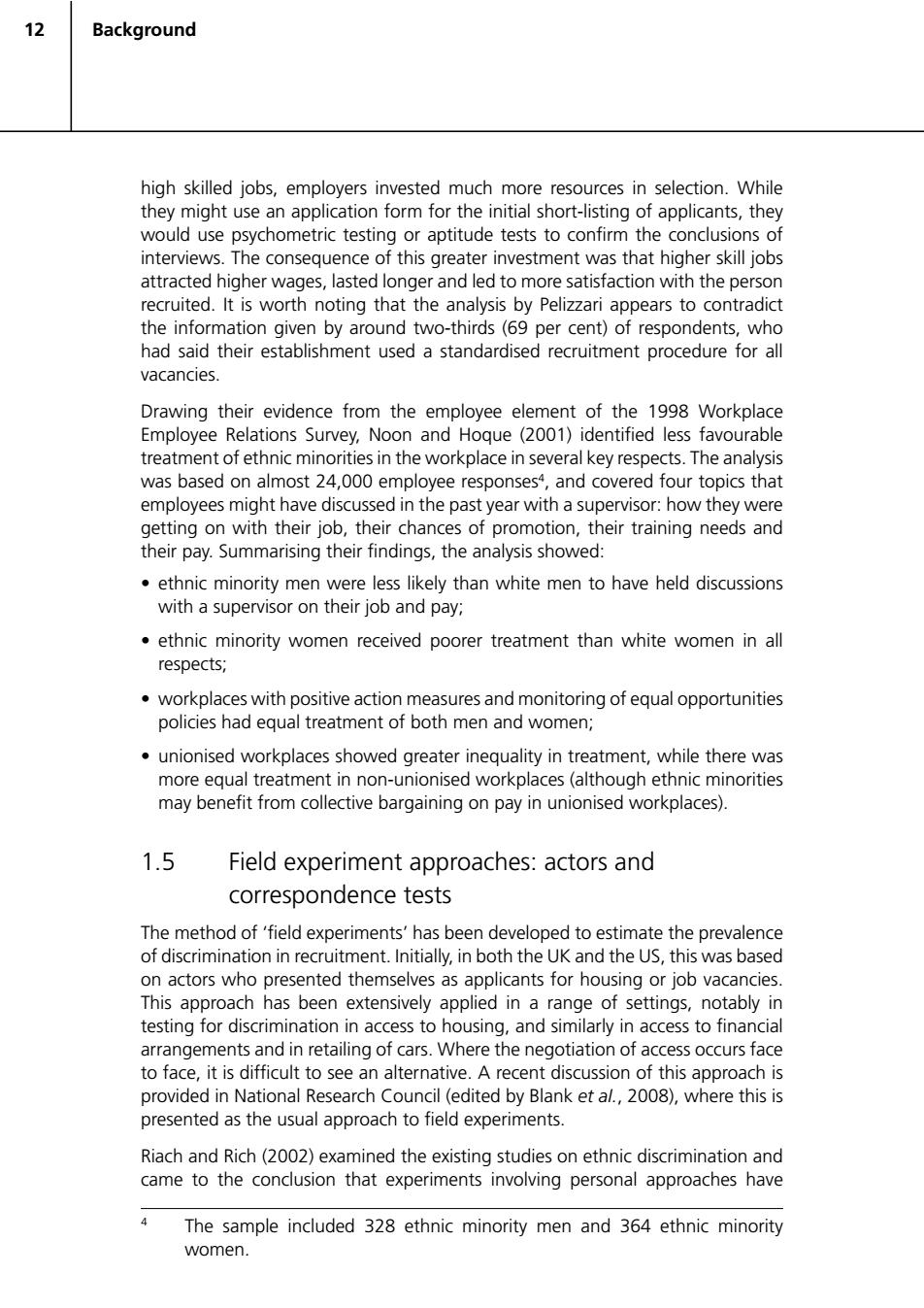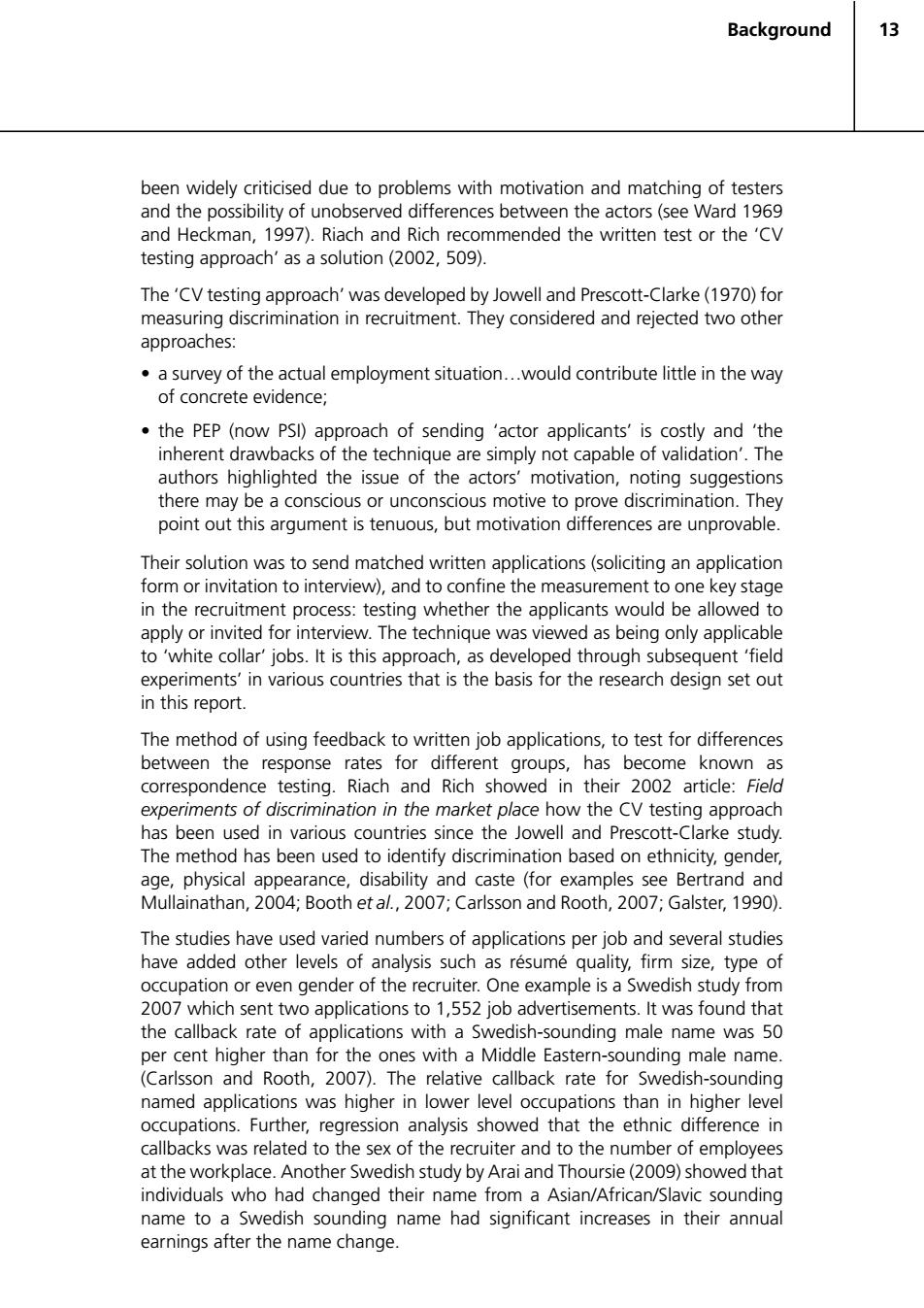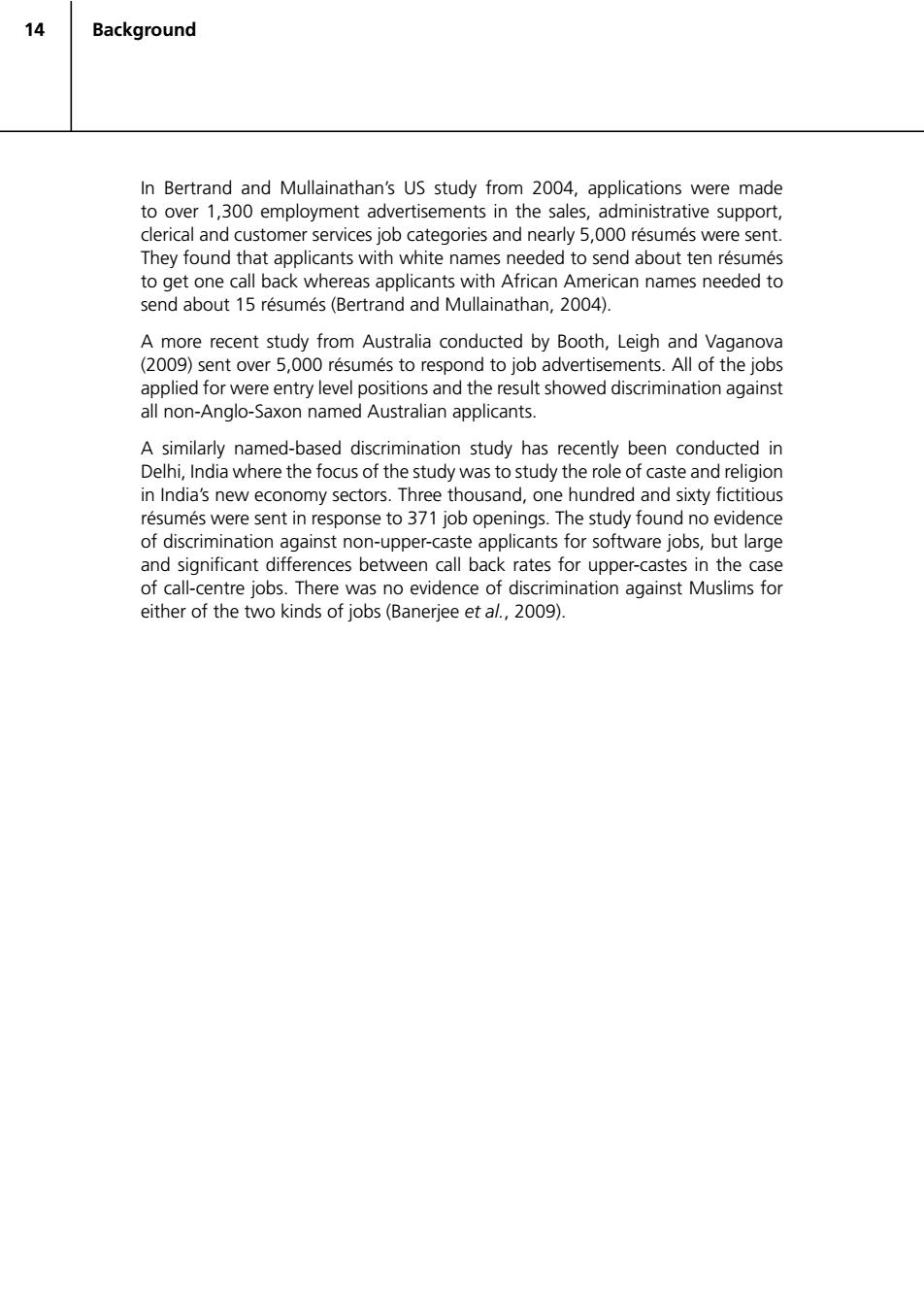
10 Background extending the Race Relations(Amendment)Act 2000 to cover the private sector, perhaps with monitoring and enforcement arrangements; as an alternative to legislation,to develop voluntary schemes for ethnic minority monitoring. The latter point is supported by the comment that: 'It may well be that a great deal of the ethnic disadvantage in the private sector is unintentional and unrecognised by senior management.Monitoring schemes may well...encourage responsible employers to address the weaknesses identified'. (2006:69) However,they are also clear that: 'One implication of our research is that more work needs to be done on the causal issues,perhaps through careful monitoring of pilot policy interventions or through field experiments on racial discrimination'. (2006:66) The National Audit Office(NAO)reported on DWP's role in increasing employment rates for ethnic minorities(NAO,2008).This report notes that the Department has used mainstream employment services as the principal instrument.While this approach has achieved a reduction in the employment gap,there is more that can be done(2008:8).The NAO makes six recommendations: all future City Strategies for areas with significant ethnic minority populations should include targets for ethnic minority employment as a condition of funding;1 in more flexible New Deal programmes,changes should be made to meet the needs of ethnic minority customers,such as in the length,content and format of training courses; Jobcentre Plus should increase awareness among ethnic minorities of reporting arrangements where discrimination has been perceived to occur; Jobcentre Plus Districts should identify services local organisations can provide to ethnic minority customers; Jobcentre Plus should bring good practice in ethnic minority employment to the attention of personal advisers; the Department and Jobcentre Plus should conduct a further customer survey of ethnic minorities to identify trends since the last survey in 2005. However,the report notes that 'the Department does not accept this recommendation on the grounds that power has been delegated to the local level and targets can be included through negotiation between the Department and local organisations'(2008:9)
10 • extending the Race Relations (Amendment) Act 2000 to cover the private sector, perhaps with monitoring and enforcement arrangements; • as an alternative to legislation, to develop voluntary schemes for ethnic minority monitoring. The latter point is supported by the comment that: ‘It may well be that a great deal of the ethnic disadvantage in the private sector is unintentional and unrecognised by senior management. Monitoring schemes may well…encourage responsible employers to address the weaknesses identified’. (2006: 69) However, they are also clear that: ‘One implication of our research is that more work needs to be done on the causal issues, perhapsthrough careful monitoring of pilot policy interventions or through field experiments on racial discrimination’. (2006: 66). The National Audit Office (NAO) reported on DWP’s role in increasing employment rates for ethnic minorities (NAO, 2008). This report notes that the Department has used mainstream employment services as the principal instrument. While this approach has achieved a reduction in the employment gap, there is more that can be done (2008: 8). The NAO makes six recommendations: • all future City Strategies for areas with significant ethnic minority populations should include targets for ethnic minority employment as a condition of funding;1 • in more flexible New Deal programmes, changes should be made to meet the needs of ethnic minority customers, such as in the length, content and format of training courses; • Jobcentre Plus should increase awareness among ethnic minorities of reporting arrangements where discrimination has been perceived to occur; • Jobcentre Plus Districts should identify services local organisations can provide to ethnic minority customers; • Jobcentre Plus should bring good practice in ethnic minority employment to the attention of personal advisers; • the Department and Jobcentre Plus should conduct a further customer survey of ethnic minorities to identify trends since the last survey in 2005. 1 However, the report notes that ‘the Department does not accept this recommendation on the grounds that power has been delegated to the local level and targets can be included through negotiation between the Department and local organisations’ (2008: 9). Background

Background 11 An EU report published in 2007(Makonnen,Measuring Discrimination,Data Collection and EU Equality Law,European Commission)drew attention to the importance of data in ensuring protection from unequal treatment.As well as national statistical sources,this was concerned with quantitative monitoring by employing organisations. 1.4 Recruitment practices and discrimination in employment It is difficult to know whether discrimination in recruitment is decreasing over time.For the US,on the basis of surveys conducted over a number of years,Holzer reported that: 'Discrimination became less pervasive in the tight labor markets of the late 1990s,as employers could no longer find alternative job applicants'. (2006:4) This illustrates one of the ways in which ethnic penalties may be related to the state of labour markets.The scope for discrimination is possibly greater where there is a high rate of unemployment and in those jobs where it is more common for recruits to have been unemployed. An analysis of recruitment behaviour showed considerable differences related to the level of skill of the job vacancy (Pelizzari,2005)2.Where the skill level was low,an employer could provide training in a very short period,and whether or not a recruit had acquired the skills needed would be apparent very quickly.The evidence showed that in this situation,employers invested little in selection and relied on a policy of 'hire and fire'once they had been able to observe which recruits were working at an appropriate level of performance3.In contrast,with This study,drawing on a 1992 survey of those responsible for recruitment in a large sample of British establishments(Hales,1993),is notable for drawing attention to the recruitment behaviour of employing organisations,whereas there is a much greater literature on the behaviour of individuals in seeking jobs.The 1992 survey included questions on equal opportunities and the measures respondents wished to adopt to improve opportunities for groups such as disabled people,the long-term unemployed and ethnic minority group members. Another perspective on the same phenomenon comes from sociological discussion of networks:if people are networked with others who face similar levels of disadvantage in the labour market,then they will tend to work in low-quality jobs with high instability,since these are the jobs that their contacts give them leads about (Granovetter,1995).An alternative 'information-based'theory would be that people applying for jobs through formal channels know little about the jobs they will be doing,and lack the existing ties to someone in the workforce to help with the settling-in time at the beginning,and this makes them likely to quit if they are not dismissed
11 An EU report published in 2007 (Makonnen, Measuring Discrimination, Data Collection and EU Equality Law, European Commission) drew attention to the importance of data in ensuring protection from unequal treatment. As well as national statistical sources, this was concerned with quantitative monitoring by employing organisations. 1.4 Recruitment practices and discrimination in employment It is difficult to know whether discrimination in recruitment is decreasing over time. For the US, on the basis of surveys conducted over a number of years, Holzer reported that: ‘Discrimination became less pervasive in the tight labor markets of the late 1990s, as employers could no longer find alternative job applicants’. (2006: 4) This illustrates one of the ways in which ethnic penalties may be related to the state of labour markets. The scope for discrimination is possibly greater where there is a high rate of unemployment and in those jobs where it is more common for recruits to have been unemployed. An analysis of recruitment behaviour showed considerable differences related to the level of skill of the job vacancy (Pelizzari, 2005)2 . Where the skill level was low, an employer could provide training in a very short period, and whether or not a recruit had acquired the skills needed would be apparent very quickly. The evidence showed that in this situation, employers invested little in selection and relied on a policy of ‘hire and fire’ once they had been able to observe which recruits were working at an appropriate level of performance3 . In contrast, with 2 This study, drawing on a 1992 survey of those responsible for recruitment in a large sample of British establishments (Hales, 1993), is notable for drawing attention to the recruitment behaviour of employing organisations, whereas there is a much greater literature on the behaviour of individuals in seeking jobs. The 1992 survey included questions on equal opportunities and the measures respondents wished to adopt to improve opportunities for groups such as disabled people, the long-term unemployed and ethnic minority group members. 3 Another perspective on the same phenomenon comes from sociological discussion of networks: if people are networked with others who face similar levels of disadvantage in the labour market, then they will tend to work in low-quality jobs with high instability, since these are the jobs that their contacts give them leads about (Granovetter, 1995). An alternative ‘information-based’ theory would be that people applying for jobs through formal channels know little about the jobs they will be doing, and lack the existing ties to someone in the workforce to help with the settling-in time at the beginning, and this makes them likely to quit if they are not dismissed. Background

12 Background high skilled jobs,employers invested much more resources in selection.While they might use an application form for the initial short-listing of applicants,they would use psychometric testing or aptitude tests to confirm the conclusions of interviews.The consequence of this greater investment was that higher skill jobs attracted higher wages,lasted longer and led to more satisfaction with the person recruited.It is worth noting that the analysis by Pelizzari appears to contradict the information given by around two-thirds (69 per cent)of respondents,who had said their establishment used a standardised recruitment procedure for all vacancies. Drawing their evidence from the employee element of the 1998 Workplace Employee Relations Survey,Noon and Hoque (2001)identified less favourable treatment of ethnic minorities in the workplace in several key respects.The analysis was based on almost 24,000 employee responses4,and covered four topics that employees might have discussed in the past year with a supervisor:how they were getting on with their job,their chances of promotion,their training needs and their pay.Summarising their findings,the analysis showed: ethnic minority men were less likely than white men to have held discussions with a supervisor on their job and pay; ethnic minority women received poorer treatment than white women in all respects; workplaces with positive action measures and monitoring of equal opportunities policies had equal treatment of both men and women; unionised workplaces showed greater inequality in treatment,while there was more equal treatment in non-unionised workplaces (although ethnic minorities may benefit from collective bargaining on pay in unionised workplaces). 1.5 Field experiment approaches:actors and correspondence tests The method of 'field experiments'has been developed to estimate the prevalence of discrimination in recruitment.Initially,in both the UK and the US,this was based on actors who presented themselves as applicants for housing or job vacancies. This approach has been extensively applied in a range of settings,notably in testing for discrimination in access to housing,and similarly in access to financial arrangements and in retailing of cars.Where the negotiation of access occurs face to face,it is difficult to see an alternative.A recent discussion of this approach is provided in National Research Council (edited by Blank et al.,2008),where this is presented as the usual approach to field experiments. Riach and Rich(2002)examined the existing studies on ethnic discrimination and came to the conclusion that experiments involving personal approaches have The sample included 328 ethnic minority men and 364 ethnic minority women
12 high skilled jobs, employers invested much more resources in selection. While they might use an application form for the initial short-listing of applicants, they would use psychometric testing or aptitude tests to confirm the conclusions of interviews. The consequence of this greater investment was that higher skill jobs attracted higher wages, lasted longer and led to more satisfaction with the person recruited. It is worth noting that the analysis by Pelizzari appears to contradict the information given by around two-thirds (69 per cent) of respondents, who had said their establishment used a standardised recruitment procedure for all vacancies. Drawing their evidence from the employee element of the 1998 Workplace Employee Relations Survey, Noon and Hoque (2001) identified less favourable treatment of ethnic minorities in the workplace in several key respects. The analysis was based on almost 24,000 employee responses4 , and covered four topics that employees might have discussed in the past year with a supervisor: how they were getting on with their job, their chances of promotion, their training needs and their pay. Summarising their findings, the analysis showed: • ethnic minority men were less likely than white men to have held discussions with a supervisor on their job and pay; • ethnic minority women received poorer treatment than white women in all respects; • workplaces with positive action measures and monitoring of equal opportunities policies had equal treatment of both men and women; • unionised workplaces showed greater inequality in treatment, while there was more equal treatment in non-unionised workplaces (although ethnic minorities may benefit from collective bargaining on pay in unionised workplaces). 1.5 Field experiment approaches: actors and correspondence tests The method of ‘field experiments’ has been developed to estimate the prevalence of discrimination in recruitment. Initially, in both the UK and the US, this was based on actors who presented themselves as applicants for housing or job vacancies. This approach has been extensively applied in a range of settings, notably in testing for discrimination in access to housing, and similarly in access to financial arrangements and in retailing of cars. Where the negotiation of access occurs face to face, it is difficult to see an alternative. A recent discussion of this approach is provided in National Research Council (edited by Blank et aI., 2008), where this is presented as the usual approach to field experiments. Riach and Rich (2002) examined the existing studies on ethnic discrimination and came to the conclusion that experiments involving personal approaches have 4 The sample included 328 ethnic minority men and 364 ethnic minority women. Background

Background 13 been widely criticised due to problems with motivation and matching of testers and the possibility of unobserved differences between the actors(see Ward 1969 and Heckman,1997).Riach and Rich recommended the written test or the 'CV testing approach'as a solution(2002,509). The'CV testing approach'was developed by Jowell and Prescott-Clarke(1970)for measuring discrimination in recruitment.They considered and rejected two other approaches: a survey of the actual employment situation...would contribute little in the way of concrete evidence; the PEP (now PSI)approach of sending 'actor applicants'is costly and 'the inherent drawbacks of the technique are simply not capable of validation'.The authors highlighted the issue of the actors'motivation,noting suggestions there may be a conscious or unconscious motive to prove discrimination.They point out this argument is tenuous,but motivation differences are unprovable. Their solution was to send matched written applications(soliciting an application form or invitation to interview),and to confine the measurement to one key stage in the recruitment process:testing whether the applicants would be allowed to apply or invited for interview.The technique was viewed as being only applicable to 'white collar'jobs.It is this approach,as developed through subsequent 'field experiments'in various countries that is the basis for the research design set out in this report. The method of using feedback to written job applications,to test for differences between the response rates for different groups,has become known as correspondence testing.Riach and Rich showed in their 2002 article:Field experiments of discrimination in the market place how the CV testing approach has been used in various countries since the Jowell and Prescott-Clarke study. The method has been used to identify discrimination based on ethnicity,gender, age,physical appearance,disability and caste (for examples see Bertrand and Mullainathan,2004;Booth et al.,2007;Carlsson and Rooth,2007;Galster,1990). The studies have used varied numbers of applications per job and several studies have added other levels of analysis such as resume quality,firm size,type of occupation or even gender of the recruiter.One example is a Swedish study from 2007 which sent two applications to 1,552 job advertisements.It was found that the callback rate of applications with a Swedish-sounding male name was 50 per cent higher than for the ones with a Middle Eastern-sounding male name. (Carlsson and Rooth,2007).The relative callback rate for Swedish-sounding named applications was higher in lower level occupations than in higher level occupations.Further,regression analysis showed that the ethnic difference in callbacks was related to the sex of the recruiter and to the number of employees at the workplace.Another Swedish study by Arai and Thoursie(2009)showed that individuals who had changed their name from a Asian/African/Slavic sounding name to a Swedish sounding name had significant increases in their annual earnings after the name change
13 been widely criticised due to problems with motivation and matching of testers and the possibility of unobserved differences between the actors (see Ward 1969 and Heckman, 1997). Riach and Rich recommended the written test or the ‘CV testing approach’ as a solution (2002, 509). The ‘CV testing approach’ was developed by Jowell and Prescott-Clarke (1970) for measuring discrimination in recruitment. They considered and rejected two other approaches: • a survey of the actual employment situation…would contribute little in the way of concrete evidence; • the PEP (now PSI) approach of sending ‘actor applicants’ is costly and ‘the inherent drawbacks of the technique are simply not capable of validation’. The authors highlighted the issue of the actors’ motivation, noting suggestions there may be a conscious or unconscious motive to prove discrimination. They point out this argument is tenuous, but motivation differences are unprovable. Their solution was to send matched written applications (soliciting an application form or invitation to interview), and to confine the measurement to one key stage in the recruitment process: testing whether the applicants would be allowed to apply or invited for interview. The technique was viewed as being only applicable to ‘white collar’ jobs. It is this approach, as developed through subsequent ‘field experiments’ in various countries that is the basis for the research design set out in this report. The method of using feedback to written job applications, to test for differences between the response rates for different groups, has become known as correspondence testing. Riach and Rich showed in their 2002 article: Field experiments of discrimination in the market place how the CV testing approach has been used in various countries since the Jowell and Prescott-Clarke study. The method has been used to identify discrimination based on ethnicity, gender, age, physical appearance, disability and caste (for examples see Bertrand and Mullainathan, 2004; Booth et al., 2007; Carlsson and Rooth, 2007; Galster, 1990). The studies have used varied numbers of applications per job and several studies have added other levels of analysis such as résumé quality, firm size, type of occupation or even gender of the recruiter. One example is a Swedish study from 2007 which sent two applications to 1,552 job advertisements. It was found that the callback rate of applications with a Swedish-sounding male name was 50 per cent higher than for the ones with a Middle Eastern-sounding male name. (Carlsson and Rooth, 2007). The relative callback rate for Swedish-sounding named applications was higher in lower level occupations than in higher level occupations. Further, regression analysis showed that the ethnic difference in callbacks was related to the sex of the recruiter and to the number of employees at the workplace. Another Swedish study by Arai and Thoursie (2009) showed that individuals who had changed their name from a Asian/African/Slavic sounding name to a Swedish sounding name had significant increases in their annual earnings after the name change. Background

14 Background In Bertrand and Mullainathan's US study from 2004,applications were made to over 1,300 employment advertisements in the sales,administrative support, clerical and customer services job categories and nearly 5,000 resumes were sent. They found that applicants with white names needed to send about ten resumes to get one call back whereas applicants with African American names needed to send about 15 resumes (Bertrand and Mullainathan,2004). A more recent study from Australia conducted by Booth,Leigh and Vaganova (2009)sent over 5,000 resumes to respond to job advertisements.All of the jobs applied for were entry level positions and the result showed discrimination against all non-Anglo-Saxon named Australian applicants. A similarly named-based discrimination study has recently been conducted in Delhi,India where the focus of the study was to study the role of caste and religion in India's new economy sectors.Three thousand,one hundred and sixty fictitious resumes were sent in response to 371 job openings.The study found no evidence of discrimination against non-upper-caste applicants for software jobs,but large and significant differences between call back rates for upper-castes in the case of call-centre jobs.There was no evidence of discrimination against Muslims for either of the two kinds of jobs(Banerjee et al.,2009)
14 In Bertrand and Mullainathan’s US study from 2004, applications were made to over 1,300 employment advertisements in the sales, administrative support, clerical and customer services job categories and nearly 5,000 résumés were sent. They found that applicants with white names needed to send about ten résumés to get one call back whereas applicants with African American names needed to send about 15 résumés (Bertrand and Mullainathan, 2004). A more recent study from Australia conducted by Booth, Leigh and Vaganova (2009) sent over 5,000 résumés to respond to job advertisements. All of the jobs applied for were entry level positions and the result showed discrimination against all non-Anglo-Saxon named Australian applicants. A similarly named-based discrimination study has recently been conducted in Delhi, India where the focus of the study was to study the role of caste and religion in India’s new economy sectors. Three thousand, one hundred and sixty fictitious résumés were sent in response to 371 job openings. The study found no evidence of discrimination against non-upper-caste applicants for software jobs, but large and significant differences between call back rates for upper-castes in the case of call-centre jobs. There was no evidence of discrimination against Muslims for either of the two kinds of jobs (Banerjee et al., 2009). Background